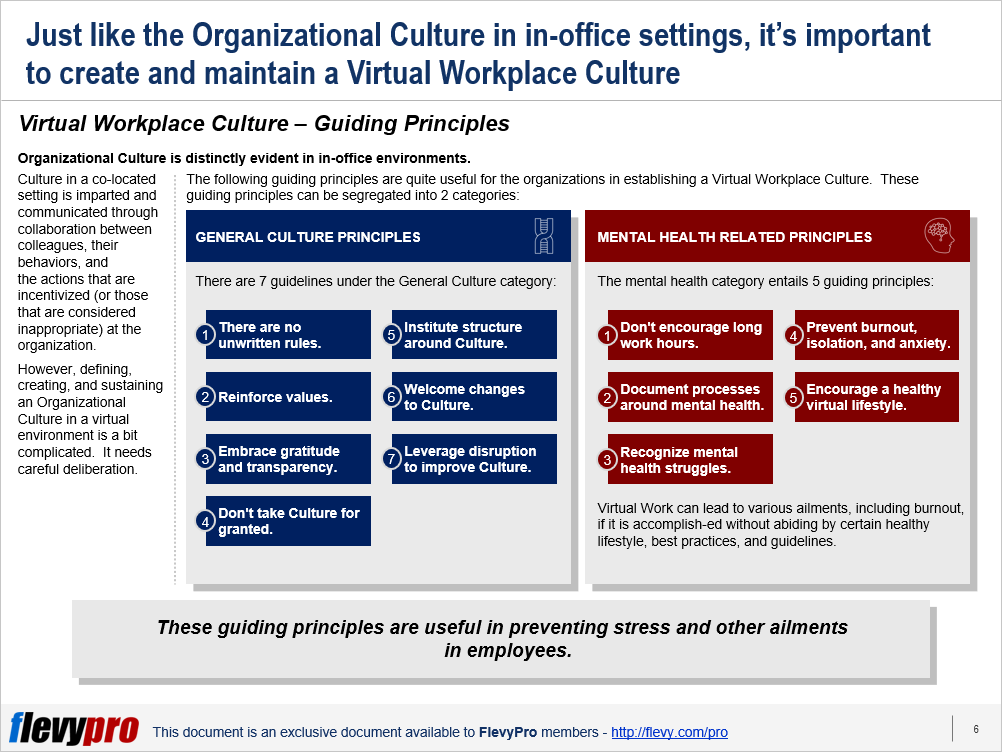Just as in a co-located setting, a remote work environment warrants a defined culture. Culture in a co-located setting is distinctly evident. It is imparted and communicated through collaboration between colleagues, their behaviors, and the actions that are incentivized—or those that are considered inappropriate—at the organization.
However, defining, creating, and sustaining an Organizational Culture in a virtual environment is a bit complicated. It needs careful deliberation. Leadership can make good use of the 12 guiding principles to inspire a robust Virtual Workplace Culture. These guiding principles can be segregated into 2 categories:
General Culture Principles
There are 7 principles under this category:
- There are no unwritten rules
- Reinforce values
- Don't take Culture for granted
- Embrace gratitude and transparency
- Institute structure around Culture
- Welcome changes to Culture
- Leverage disruption to improve Culture
Mental Health Related Principles
Virtual Work can lead to various ailments, including burnout, if it is accomplished without abiding by healthy lifestyle, best practices, and guidelines. The mental health category entails 5 guiding principles:
- Don't encourage long work hours
- Document processes around mental health
- Recognize mental health struggles
- Prevent burnout, isolation, and anxiety
- Encourage a healthy virtual lifestyle
Let’s dive deeper into 4 of these guiding principles.
1. There are no unwritten rules
The first principle to foster a Remote Culture necessitates documented policies and systems. Careful documentation assists in prohibiting decline of a remote enterprise and culture. The first instance to document should be the company values including teamwork, productivity, clarity, diverseness, and inclusivity.
2. Reinforce values
The actions that are encouraged and rewarded by the company become organizational values. For instance, in virtual settings, hiring, promoting, and developing people play a huge role in encouraging and underlining the importance of values. The values dear to an organization are displayed through role modeling of required behaviors by the leadership. They are manifested by the people the organization hires and let go off. Organizational values are also evident by the yardsticks used to gauge qualification for increments, rewards, promotions, and performance management.
3. Embrace gratitude and transparency
Without clear-cut information sharing and appreciation, employees may begin to feel cynical and unenthusiastic. This can eat away at the organization culture. Leaders should be careful with 360 performance evaluation and feedback. Negative feedback should be delivered in a positive manner to instill hope and determination to do better. There is also a need to take drastic measures if there is a general sense of lack of appreciation and transparency prevalent among employees.
4. Don't take Culture for granted
Culture is easily emphasized in a co-located setting, collaborating with colleagues day after day. However, underscoring the significance of culture in a virtual environment demands cautious deliberation. Various core elements of culture are often present, but are masked in our daily activities and habits. These elements are manifested by “how we do things in our organization.” These common habits are the hallmark of belonging to a culture.
In remote settings, leaders need to highlight the elements of culture that are evident in such settings and their importance, since these practices are a bit hard to observe in virtual teams. Leadership should mark boundaries of culture clearly and define what is disrespectful or unacceptable in their organizational culture.
Interested in learning more about the other guiding principles of Virtual Work Culture? You can download an editable PowerPoint presentation on Virtual Work: Corporate Culture here on the Flevy documents marketplace.
Do You Find Value in This Framework?
You can download in-depth presentations on this and hundreds of similar business frameworks from the FlevyPro Library. FlevyPro is trusted and utilized by 1000s of management consultants and corporate executives. Here’s what some have to say:
“My FlevyPro subscription provides me with the most popular frameworks and decks in demand in today’s market. They not only augment my existing consulting and coaching offerings and delivery, but also keep me abreast of the latest trends, inspire new products and service offerings for my practice, and educate me in a fraction of the time and money of other solutions. I strongly recommend FlevyPro to any consultant serious about success.”
– Bill Branson, Founder at Strategic Business Architects
“As a niche strategic consulting firm, Flevy and FlevyPro frameworks and documents are an on-going reference to help us structure our findings and recommendations to our clients as well as improve their clarity, strength, and visual power. For us, it is an invaluable resource to increase our impact and value.”
– David Coloma, Consulting Area Manager at Cynertia Consulting
“As a small business owner, the resource material available from FlevyPro has proven to be invaluable. The ability to search for material on demand based our project events and client requirements was great for me and proved very beneficial to my clients. Importantly, being able to easily edit and tailor the material for specific purposes helped us to make presentations, knowledge sharing, and toolkit development, which formed part of the overall program collateral. While FlevyPro contains resource material that any consultancy, project or delivery firm must have, it is an essential part of a small firm or independent consultant’s toolbox.”
– Michael Duff, Managing Director at Change Strategy (UK)

Replies